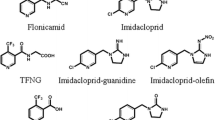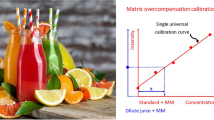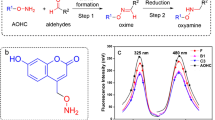Abstract
A simple method for the verification of supplemental (6R,S)-5-methyl-5,6,7,8-tetrahydrofolic acid, “5-MTHF,” in nutritional products is described. Nutritional product samples are prepared for the liquid chromatographic/fluorescence detection (LC/FLD) determination of 5-MTHF by buffer dilution, 10-min centrifugation, and syringe filtration. Method performance has been defined by assessments of 5-MTHF linearity (r 2 averaged 0.9999 ± 0.0001, and all relative calibration errors averaged ≤0.6%, for ten consecutive six-point standard curves), intermediate precision (rsd = 1.1%, n = 9, for three products fortified at ∼1.73 μmol/kg = ∼795 μg/kg, tested on each of 3 days), accuracy (spike recovery average = 92.8 ± 1.0%, n = 9, for nutritional products spiked with 5-MTHF at ∼1.73 μmol/kg, or ∼795 μg/kg), and selectivity (absence of interference from reagent blanks, and from four compounds structurally related to 5-MTHF). The 5-MTHF recovery, as % of unheated controls, from a simulated heat treatment (20 min at 120 °C) averaged 99.1 ± 0.6%, n = 4. The limits of 5-MTHF detection (S/N = 3) and quantification (S/N = 10) were experimentally determined to be 10 μg/kg (∼0.020 μmol/kg) and 30 μg/kg (∼0.060 μmol/kg), respectively (<10× the expected fortification rate). The method provides a simple and inexpensive means for verifying proper fortification, and for assessing the stability to processing and storage conditions, of free 5-MTHF in nutritional products. A finding of interest is the indication that liquid nutritional products may comprise a stable matrix for 5-MTHF fortification.


Similar content being viewed by others
References
Abramsky L, Dolk H (2007) Should Europe fortify a staple food with folic acid? Lancet 369:641–642
Arcot J, Shrestha A (2005) Folate: methods of analysis. Trends Food Sci Technol 16:253–266
Bourassa P, Tajmir-Riahi HA (2012) Locating the binding sites of folic acid with milk α- and β-caseins. J Phys Chem B 116:513–519
Chandra-Hioe MV, Addepalli R, Osborne SA, Slapetova I, Whan R, Bucknall MP, Arcot J (2013) Transport of folic acid across Caco-2 cells is more effective than 5-methyltetrahydrofolate following the in vitro digestion of fortified bread. Food Res Int 53:104–109
Doherty RF, Beecher GR (2003) A method for the analysis of natural and synthetic folate in foods. J Agric Food Chem 51:354–361
Gliszczynska-Swiglo A, Muzolf M (2007) pH-dependent radical scavenging activity of folates. J Agric Food Chem 55:8237–8242
Green TJ, Liu Y, Dadgar S, Li W, Bohni R, Kitts DD (2013) Wheat rolls fortified with microencapsulated L-5-methyltetrahydrofolic acid or equimolar folic acid increase blood folate concentrations to a similar extent in healthy men and women. J Nutr 143:867–871
Hesdorffer CS, Longo DL (2015) Drug-induced megaloblastic anemia. New Engl J Med 373:1649–1658
Houghton LA, Sherwood KL, Pawlosky R, Ito S, O’Connor DL (2006) [6S]-5-methyltetrahydrofolate is at least as effective as folic acid in preventing a decline in blood folate concentrations during lactation. Am J Clin Nutr 83:842–850
Indrawati, Arroqui C, Messagie I, Nguyen MT, van Loey A, Hendrickx M (2004a) Comparative study on pressure and temperature stability of 5-methyltetrahydrofolic acid in model systems and in food products. J Agric Food Chem 52:485–492
Indrawati, Verlinde P, Ottoy F, van Loey A, Hendrickx M (2004b) Implications of β-mercaptoethanol in relation to folate stability and to determination of folate degradation kinetics during processing: a case study on [6S]-5-methyltetrahydrofolic acid. J Agric Food Chem 52:8247–8254
Indrawati, van Loey A, Hendrickx (2005) Pressure and temperature stability of 5-methyltetrahydrofolic acid: a kinetic study. J Agric Food Chem 53:3081–3087
Jacob JA (2016) Twenty years after folic acid fortification, FDA ponders expansion to corn masa flour. JAMA 315:1821–1822
Jagerstad M, Piironen V, Walker C, Ros G, Carnovale E, Holasova M, Nau H (2005) Increasing natural food folates through bioprocessing and biotechnology. Trends Food Sci Technol 16:298–306
Liu Y, Tomiuk S, Rozoy E, Simard S, Bazinet L, Green T, Kitts DD (2012) Thermal oxidation studies on reduced folate, L-5-methyltetrahydrolic acid (L-5-MTHF) and strategies for stabilization using food matrices. J Food Sci 77:C236–C243
Liu Y, Green TJ, Wong P, Kitts DD (2013) Microencapsulation of L-5-methyltetrahydrofolic acid with ascorbate improves stability in baked bread products. J Agric Food Chem 61:247–254
Mason JB, Cole BF, Baron JA, Kim YI, Smith AD (2008) Folic acid fortification and cancer risk. Lancet 371:1335
Mekmene O, Gaucheron F (2011) Determination of calcium-binding constants of caseins, phosphoserine, citrate and pyrophosphate: a modeling approach using free calcium measurement. Food Chem 127:676–682
Nguyen MT, Indrawati, Hendrickx M (2003) Model studies on the stability of folic acid and 5-methyltetrahydrofolic acid degradation during thermal treatment in combination with high hydrostatic pressure. J Agric Food Chem 51:3352–3357
Oey I, Verlinde P, Hendrickx M, van Loey A (2006) Temperature and pressure stability of L-ascorbic acid and/or [6s] 5-methyltetrahydrofolic acid: a kinetic study. Eur Food Res Technol 223:71–77
Oey I, van der Plancken I, van Loey A, Hendrickx M (2008) Does high pressure processing influence nutritional aspects of plant based food systems? Trends Food Sci Technol 19:300–308
Pawlosky RJ, Flanagan VP, Doherty RF (2003) A mass spectrometric validated high-performance liquid chromatography procedure for the determination of folates in foods. J Agric Food Chem 51:3726–3730
Pentieva K, McNulty H, Reichert R, Ward M, Strain JJ, McKillop DJ, McPartlin JM, Connolly E, Molloy A, Kramer K, Scott JM (2004) The short term bioavailabilities of [6S]-5-methyltetrahydrofolate and folic acid are equivalent in men. J Nutr 134:580–585
Powers HJ (2007) Folic acid under scrutiny. Br J Nutr 98:665–666
Rychlik M, Englert K, Kapfer S, Kirchhoff E (2007) Folate contents of legumes determined by optimized enzyme treatment and stable isotope dilution assays. J Food Comp Anal 20:411–419
Strandler HS, Patring J, Jagerstad M, Jastrebova J (2015) Challenges in the determination of unsubstituted food folates: impact of stabilities and conversions on analytical results. J Agric Food Chem 63:2367–2377
Thomas PM, Flanagan VP, Pawlosky RJ (2003) Determination of 5-methyltetrahydrofolic acid and folic acid in citrus juices using stable isotope dilution-mass spectrometry. J Agric Food Chem 51:1293–1296
Tomiuk S, Liu Y, Green TJ, King MJ, Finglas PM, Kitts DD (2012) Studies on the retention of microencapsulated L-5-methyltetrahydrofolic acid in baked bread using skim milk powder. Food Chem 133:249–255
Vaish S, White M, Daly L, Molloy AM, Staines A, Sweeney MR (2016) Synthetic folic acid intakes and status in children living in Ireland exposed to voluntary fortification. Am J Clin Nutr 103:512–518
Valera-Gran D, de la Hera MG, Navarrete-Munoz EM, Fernandez-Somoano A, Tardon A, Julvez J, Forns J, Lertxundi N, Ibarluzea JM, Murcia M, Rebagliato M, Vioque J (2014) Folic acid suuplements during pregnancy and child psychomotor development after the first year of life. JAMA Pediatr 168(11):e142611
Venn BJ, Green TJ, Moser R, Mckenzie JE, Skeaff CM, Mann J (2002) Increases in blood folate indices are similar in women of childbearing age supplemented with [6S]-5-methyltetrahydrofolate and folic acid. J Nutr 132:3353–3355
Verlinde PHCJ, Oey I, Deborggraeve WM, Hendrickx ME, van Loey AM (2009) Mechanism and related kinetics of 5-methyltetrahydrofolic acid degradation under combined high hydrostatic pressure-thermal treatments. J Agric Food Chem 57:6803–6814
Verwei M, Arkbage K, Havenaar R, van den Berg H, Witthoft C, Schaafsma G (2003) Folic acid and 5-methyltetrahydrofolate in fortified milk are bioaccessible as determined in a dynamic in vitro gastrointestinal model. J Nutr 133:2377–2383
Voelker MSJ (2015) Higher folic acid intake needed. JAMA 313:1094
Vollset SE, Clarke R, Lewington S, Ebbing M, Halsey J, Lonn E, Armitage J, Manson JE, Hankey GJ, Spence JD, Galan P, Bonaa KH, Jamison R, Gaziano JM, Guarino P, Baron JA, Logan RFA, Giovanucci EL, den Heijer M, Ueland PM, Bennett D, Collins R, Peto R (2013) Effects of folic acid supplementation on overall and site-specific cancer incidence during the randomized trials: meta-analysis of data on 50 000 individuals. Lancet 381:1029–1036
Wang C, Riedl KM, Somerville J, Balasubramaniam WM, Schwartz SJ (2011) Influence of high pressure processing on the profile of polyglutamyl 5-methyltetrahydrofolate in selected vegetables. J Agric Food Chem 59:8709–8717
Wright AJA, King MJ, Wolfe CA, Powers HJ, Finglas PM (2010) Comparison of (6S)-5-methyltetrahydrofolic acid vs. folic acid as the reference folate in longer-term human dietary intervention studies assessing the relative bioavailability of natural food folates: comparative changes in folate status following a 16-week placebo-controlled study in healthy adults. Br J Nutr 103:724–729
Zhang T, Xue H, Zhang B, Zhang Y, Song P, Tian X, Xing Y, Wang P, Meng M, Xi R (2012) Determination of folic acid in milk, milk powder and energy drink by an indirect immunoassay. J Sci Food Agric 92:2297–2304
Author information
Authors and Affiliations
Corresponding author
Ethics declarations
Conflict of Interest
Paul W. Johns declares that he has no conflict of interest. Jeffrey H. Baxter declares that he has no conflict of interest. Megan C. Terp declares that she has no conflict of interest.
Human and Animal Studies
This article contains no study with human or animal subjects.
Informed Consent
Not applicable.
Rights and permissions
About this article
Cite this article
Johns, P.W., Baxter, J.H. & Terp, M.C. Verification of 5-Methyltetrahydrofolic Acid in Nutritional Products. Food Anal. Methods 10, 3255–3263 (2017). https://doi.org/10.1007/s12161-017-0898-y
Received:
Accepted:
Published:
Issue Date:
DOI: https://doi.org/10.1007/s12161-017-0898-y




